Explore Khajuraho’s UNESCO temples, rich culture, and travel tips. A perfect guide for international visitors to discover Madhya Pradesh’s heritage.
Imagine a small town in central India, where intricate stone carvings from the 10th century still whisper stories of love, devotion, and everyday life. Khajuraho, a UNESCO World Heritage Site in Madhya Pradesh, is home to some of the world’s most remarkable temples — celebrated not just for their art but also for their symbolism and history.
Khajuraho is often described as the land of “erotic temples,” but that is only part of its story. The carvings here reflect much more — devotion, creativity, philosophy, and the celebration of life in all its forms. For travelers, it’s a chance to step back in time and experience a slice of Indian heritage that is as profound as it is beautiful.
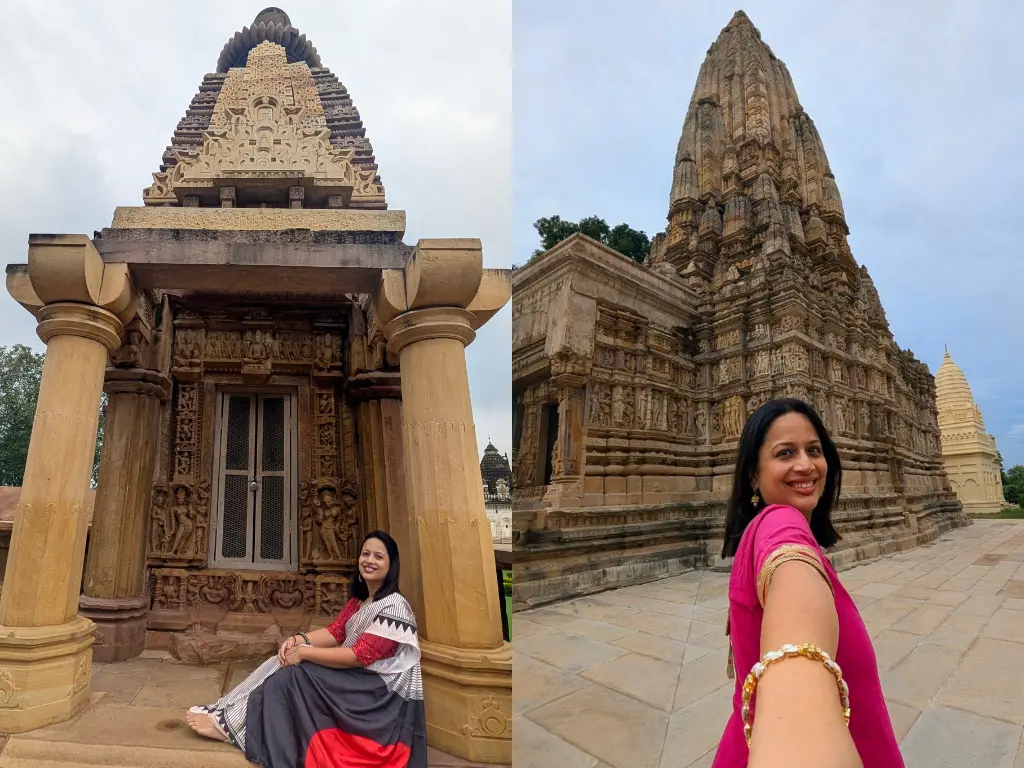
Why Visit Khajuraho?
- UNESCO World Heritage Temples – Khajuraho is home to around 85 temples (of which 25 remain well-preserved), built between 950–1050 CE by the Chandela dynasty. The artistry and symbolism of these temples have few parallels in the world.
- A Celebration of Life in Stone – The carvings aren’t limited to religion. They depict music, dance, love, festivals, and even the rhythms of daily life, making the temples a unique chronicle of Indian society from a thousand years ago.
- Spiritual & Architectural Significance – With influences of Hinduism and Jainism, Khajuraho temples blend spirituality with stunning architecture. The temples are laid out in harmony with cosmic principles, which makes the site not just visually striking but deeply symbolic.
- Beyond Temples – Khajuraho isn’t just about monuments. The town also offers vibrant cultural performances, handicraft markets, and access to nearby natural wonders like Raneh Falls and Panna National Park, making it an excellent addition to a broader India itinerary.
How to Reach Khajuraho?
Despite being a small town, Khajuraho is fairly well-connected by air, rail, and road, though accessibility can sometimes feel limited compared to bigger Indian cities.
- By Air ✈️
Khajuraho has its own airport (IATA: HJR), located about 3 km from the main town. However, flights are limited and operational in peak seasons only (October – March) — mostly connecting to Delhi and Varanasi. For international travelers, the best option is to fly into Delhi or Varanasi and then take a connecting flight to Khajuraho. - By Train 🚆
Khajuraho Railway Station is about 6 km from the town and connects to cities like Delhi, Jhansi, and Varanasi. If you’re traveling from elsewhere in Madhya Pradesh, Jhansi and Satna are major junctions with more frequent trains. From there, you can take a taxi or bus to Khajuraho. However, you need to book your tickets in advance (Online via irctc.com or from a reliable travel agent). - By Road 🛣️
Buses and taxis connect Khajuraho to cities like Jhansi, Satna, Bhopal, and Varanasi. Taxis are comfortable and convenient. We visited Khajuraho from Bhopal, via private car and it took about 7–8 hours. The roads are good, but single-lane stretches can make the journey time-consuming. For travelers who enjoy scenic drives, it’s a great way to see rural Madhya Pradesh.
👉 Tip: If you’re short on time, flying is the best option. If you’re exploring central India more broadly, consider the train + car combo for a balance of comfort and cost.
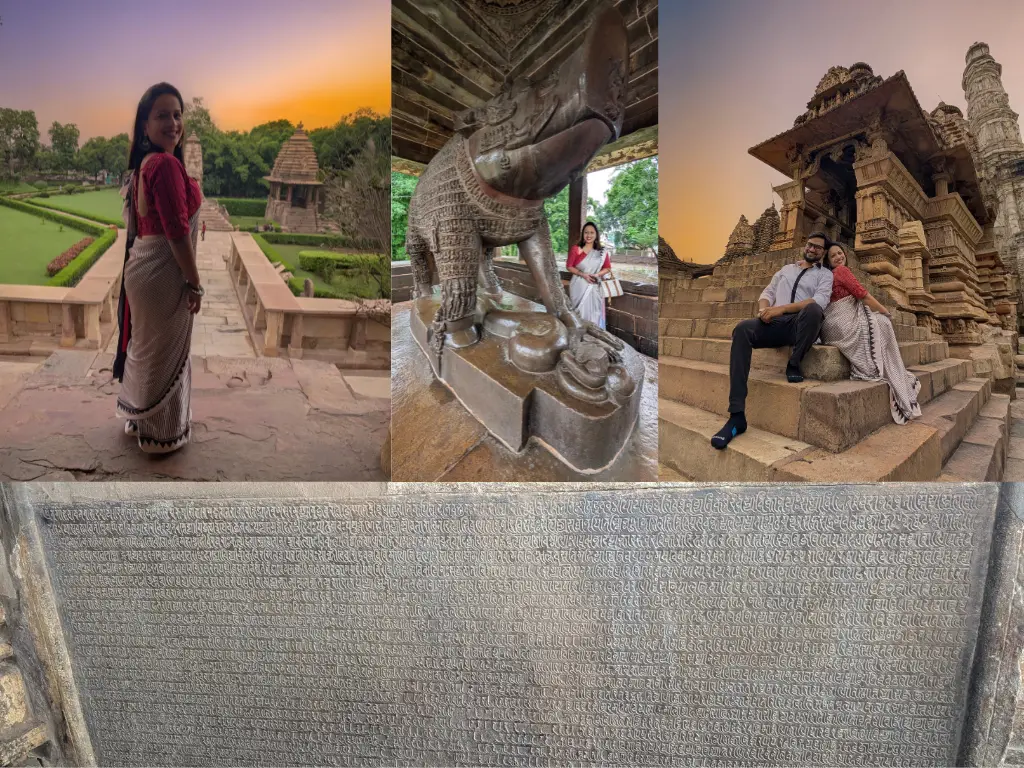
Best Time to Visit Khajuraho
- Winter (October – March): The most pleasant season with cool weather (8–20°C). Ideal for temple visits and outdoor sightseeing.
- Summer (April – June): Can get very hot (up to 45°C), not recommended unless you’re used to Indian summers.
- Monsoon (July – September): Lush and green, but humidity and rains may interrupt plans. Good if you prefer fewer tourists.
We visited in August and the weather was humid but lush greens; however, rains disrupted a bit of the trip. You can keep a day buffer if you plan to visit in monsoon.
👉 Tip: For international visitors, November to February is the sweet spot — comfortable weather, cultural festivals, and photography-friendly light.
Top Temples & Attractions
Khajuraho is divided into three groups of temples — Western, Eastern, and Southern. Western Group is the most famous and a UNESCO World Heritage Site.
Western Group of Temples
This is where you should begin, and ideally, hire a licensed guide (approx. ₹2,500 for a half-day, 4 hours; ₹4,000 for a full day). Guides can be booked through hotels or at the temple complex itself. A guide is highly recommended — the sculptures and layouts are full of symbolism that you’ll likely miss otherwise. The temples open at 6 am so start early to avoid crowds and witness beautiful morning sky.
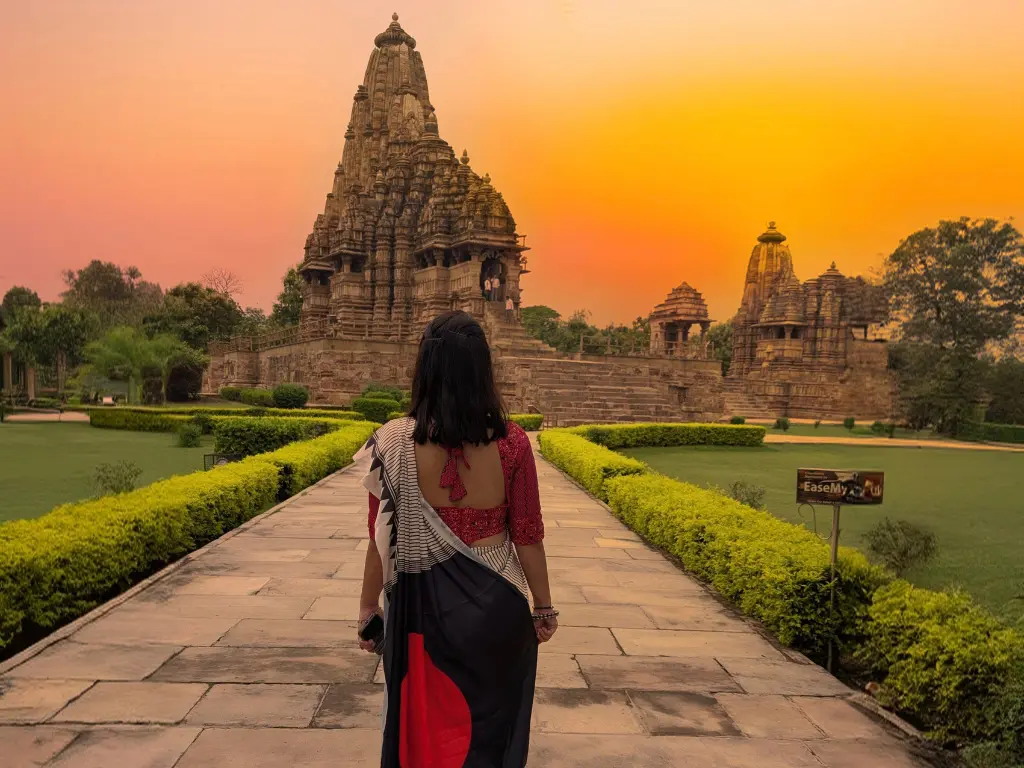
- Kandariya Mahadev Temple
The largest and grandest temple of Khajuraho, dedicated to Lord Shiva. It rises over 30 meters high, its spire designed to resemble Mount Meru, the mythical mountain at the center of the universe. Its walls are covered with nearly 900 intricate sculptures, from divine beings to celestial nymphs and scenes of daily life. - Lakshmana Temple
One of the oldest temples in the complex, built in the 10th century, dedicated to Lord Vishnu. Its outer walls are decorated with a wide range of carvings — warriors, musicians, dancers, animals, and mythological scenes. This temple is particularly striking at sunset when the carvings glow in golden light. - Vishwanath & Chitragupta Temples
Vishwanath is dedicated to Shiva and houses a massive stone Nandi bull, while Chitragupta is dedicated to Surya (the Sun God) and has a beautiful idol of him riding a seven-horse chariot. - Varaha Shrine: A significant sandstone structure in the Western Group of the Khajuraho Group of Monuments. This temple houses a colossal monolithic sculpture of Varaha, the boar incarnation of the Hindu deity Vishnu, who rescued the Earth (Bhudevi) from beneath the cosmic ocean.
👉 Tickets: Entry is ₹40 for Indian citizens and ₹600 for foreigners.
Eastern Group of Temples
Located about 2 km from the Western Group, these temples are mainly Jain temples but equally intricate.
- Parsvanath Temple: The largest Jain temple here, famous for its fine wall sculptures, including celestial maidens and everyday village life.
- Adinath Temple: Smaller but notable for its delicate carvings and Jain influence.
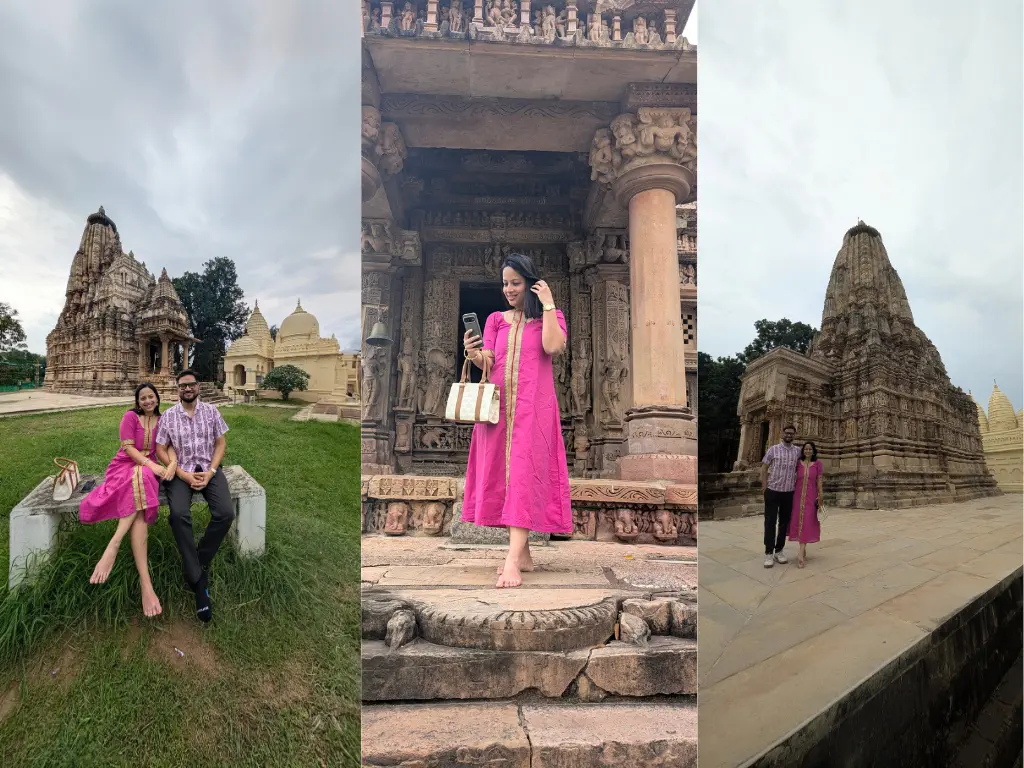
Southern Group of Temples
These are less crowded and ideal if you want a quieter experience.
- Duladeo Temple: Dedicated to Shiva, with beautifully carved apsaras (celestial dancers) on its walls.
- Chaturbhuj Temple: Uniquely, this temple doesn’t have erotic sculptures. Instead, it houses a huge idol of Vishnu, almost 3 meters tall, radiating calm.
Matangeshvara Temple:
Among the many historic temples in Khajuraho, Matangeshvara Temple stands out for its spiritual significance and ongoing religious activity. Unlike most of the Chandela-era monuments, which are now primarily archaeological sites, this temple is still actively used for worship by locals. This temple is located very close to the Western Group of Temples.
Dedicated to Lord Shiva, the temple houses a large Shiva Lingam, believed to be a “living lingam” that grows slightly every year — a unique feature that adds to its mystique. It is considered one of the oldest and holiest temples in the Khajuraho complex.
Cultural Experiences
- Sound & Light Show at Western Temples: Held every evening at the Western Group of Temples in both Hindi and English. Tickets cost ₹300 per person. It’s a laser-based show that narrates the story of the Chandela dynasty and the making of these temples.
👉 Note: The show is canceled if it rains, so always check the weather forecast before planning.
- Khajuraho Dance Festival (Feb/March): A week-long celebration of Indian classical dance with temples as the backdrop.
- Tribal Museum (State Museum of Tribal and Folk Art): A must-visit is the Tribal and Folk Art Museum, which showcases the vibrant culture of Madhya Pradesh’s indigenous tribes. Here you’ll find traditional tools, costumes, masks, artworks, and household objects that give insight into tribal life. It’s a great complement to the temples — offering context about the people who still live around Khajuraho.
- Nature & Wildlife: Panna National Park (around 45 minutes away) is home to tigers, leopards, and gharials, perfect for adding a safari to your trip. Raneh Falls is another wonder (Grand canyon of India ) which is just 20 kms from Khajuraho (Read about Raneh Falls here).
🍴 Food Options:
- Raja Café – Popular for continental meals, coffee, and light snacks.
- Pinch of Salt – Famous among locals for authentic flavors and a casual vibe. Their Hara Bhara Kebabs are delicious.
- Kosmic – Laid-back café offering cocktails, mocktails, and a relaxed environment. Perfect for unwinding after temple visits.
- Panna Restaurant: For traditional Madhya Pradesh cuisine, The restaurant in Lalit Temple View , Panna Restaurant offers authentic Bundelkhand Thali (pre-order recommended) and unique local desserts like Pyas Kheer (sweet onion porridge)— a must-try culinary experience in Khajuraho.
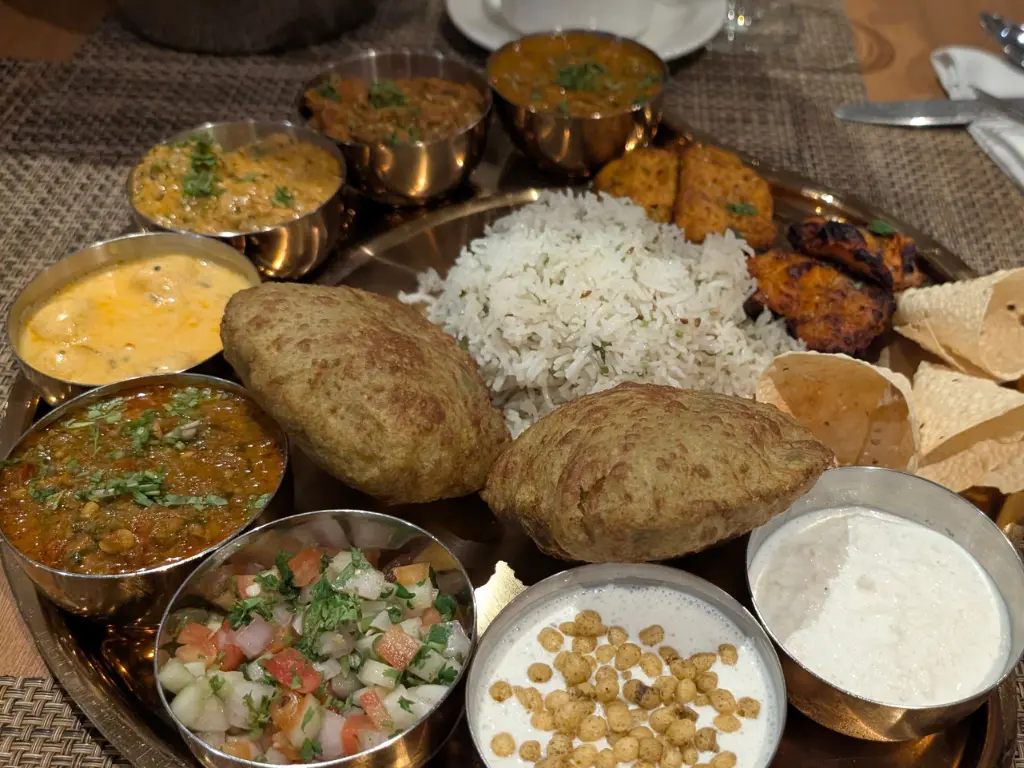
Where to Stay
Khajuraho may be a small town, but it offers a variety of accommodation options to suit different budgets:
- Luxury
- The Lalit Temple View – Offers excellent views of the Western group of temples, spacious rooms, and modern amenities. Approx. ₹7,000–₹12,000 per night.
- Radisson Blu Hotel Khajuraho – Modern amenities, spacious rooms, and a pool. Approx. ₹6,000–₹10,000 per night. Perfect for international travelers seeking comfort and luxury.
- We chose to stay at Lalit at the Temple View Room. The hospitality, stay, and the food was fabulous.
- Mid-Range:
- Ramada Khajuraho – Centrally located, good for families and international travelers. Approx. ₹3,500–₹6,000 per night.
- Hotel Isabel Palace – Charming and clean, with helpful staff. Approx. ₹2,500–₹5,000 per night.
- Budget:
- Zostel Khajuraho – Backpacker-friendly with a social vibe. Approx. ₹500–₹1,200 per night.
- Family-run guesthouses near the temples, Approx. ₹800–₹1,500 per night.
- AirBnbs:
Khajuraho offers a wide range of Airbnb accommodations that cater to international as well as local travelers seeking comfort, authenticity, and convenience. Here are some top-rated options to consider:
🏡 Top-Rated Airbnb Stays in Khajuraho
Happy Home Stay (Rating: 4.93/5)
The High Vill Home Stay (Rating: 4.7/5)
Casa Maria Homestay (Rating: 4.82/5)
Shivansh HomeStay & Marriage Garden (Rating: 4.67/5)
✅ Tips for Booking Airbnb in Khajuraho
- Proximity to Temples: Opt for accommodations near the Western Group of Temples for easy access to major attractions.
- Amenities: Ensure the property offers essential amenities like Wi-Fi, air conditioning, and hot water.
- Local Experience: Consider homestays for an authentic cultural experience and home-cooked meals.
- Reviews: Always read guest reviews to ensure the quality and reliability of the stay.
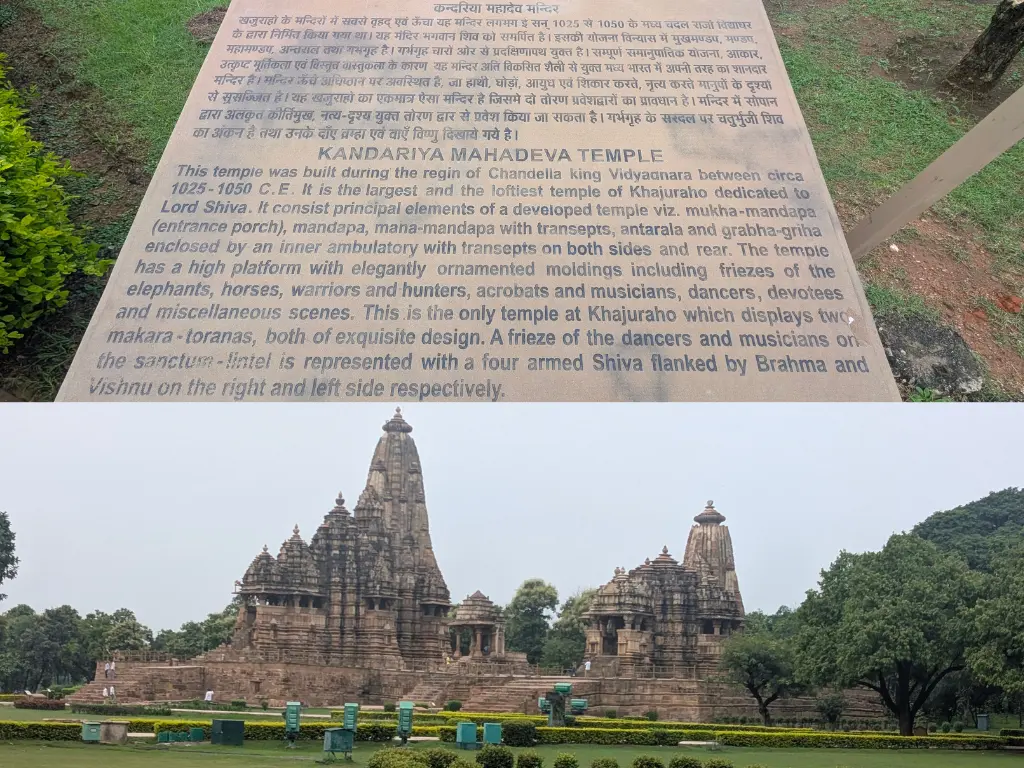
Travel Tips for International Visitors
- Dress Respectfully: When visiting temples, it’s best to cover shoulders and knees out of respect for local customs.
- Stay Hydrated: Carry bottled water, especially while exploring temples or outdoor sites. Tap water is best avoided. You do get bottled water easily.
- Insect Protection: Mosquitoes can be common, particularly in the evenings or near water bodies. Apply repellent and consider light long-sleeved clothing.
- Footwear: Most temples require you to remove shoes before entering, so slip-on shoes or comfortable sandals are convenient.
- Photography: Capture the beauty of temples and take back memories. Note that drones are not allowed and there are extra charges for videography.
- Currency: While most restaurants and hotels accept cards, having some cash on hand is useful for smaller vendors, local tips, or temple donations.
Local Interaction
One of the highlights of visiting Khajuraho is the warmth and hospitality of its people. The locals are friendly, approachable, and always happy to share insights about their culture, traditions, and the temples. Conversations with residents — whether it’s a guide explaining the carvings or a shopkeeper sharing local tips — enrich your travel experience and give a glimpse into the living heritage of this historic town. Guides know English well and there are some guides which speak foreign languages also.
Shopping in Khajuraho
While exploring Khajuraho, don’t miss the chance to pick up some unique souvenirs and local handicrafts:
- Handicrafts & Souvenirs: Local markets have brass and stone sculptures, miniature temple replicas, traditional jewelry, and wooden carvings inspired by the temple art.
- Textiles: Cotton and silk fabrics, scarves, and bags made by local artisans are popular keepsakes.
- Local Artwork: You’ll find paintings and prints depicting Khajuraho’s temple carvings and rural life in Madhya Pradesh.
- Shopping Spots: The main market near the Western Group of Temples has small stalls and shops. Many hotels also have gift shops with curated local crafts.
Tip: Bargaining is common in local markets, and it’s part of the fun. Carry some small cash notes, as most vendors don’t accept cards.
Next Destination
We visited Orchha after Khajuraho — a charming riverside town dotted with palaces, cenotaphs, and temples (Detail blog about Orchha). It makes a perfect extension to your Khajuraho trip, and you can also club it with Jhansi, Varanasi, or other hidden gems of Madhya Pradesh for a richer cultural experience.
Final Words:
Khajuraho isn’t just a destination; it’s an experience waiting to unfold. Wander through the ancient temples, admire the intricate carvings, and let your imagination travel back to the Chandela era. Pause at Matangeshvara Temple to feel the spiritual energy, or spend a quiet evening at Raneh Falls and let nature take center stage. Every street, every carving, and every local story adds a layer to your journey. So pack your curiosity, bring your camera, and let Khajuraho surprise you — history, culture, and adventure all rolled into one unforgettable experience!
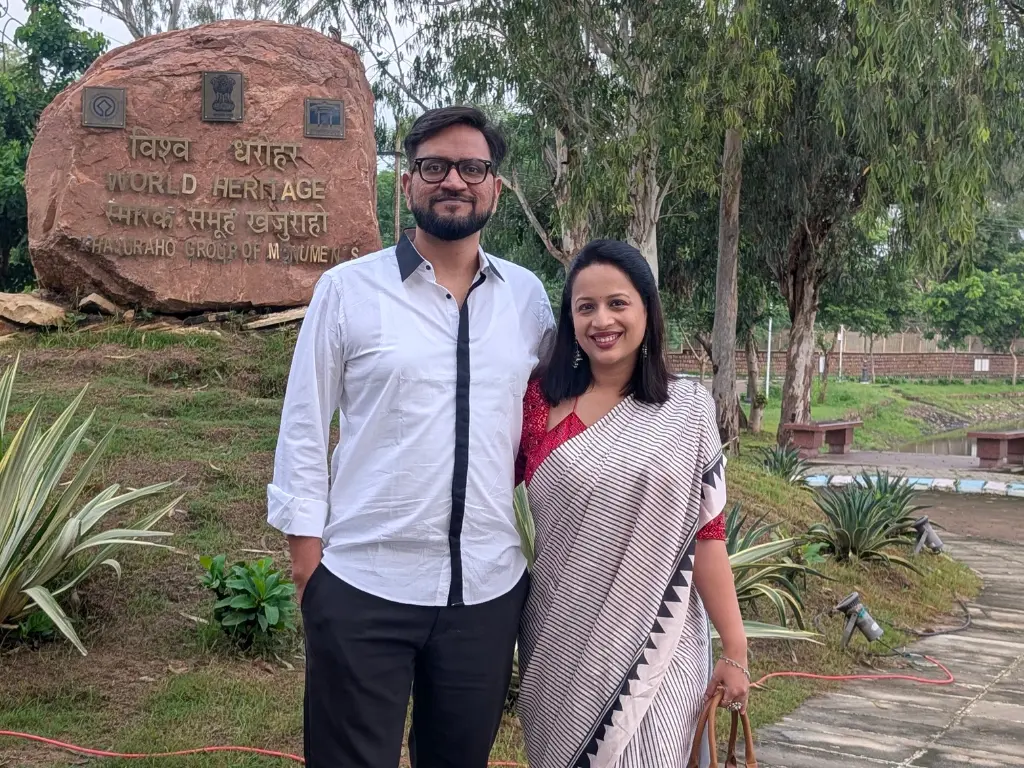
FAQs
1. What is the best time to visit Khajuraho?
October to March is ideal, with pleasant weather and clear skies perfect for exploring temples and nearby attractions.
2. How do I reach Khajuraho?
You can reach Khajuraho by train, road, or flight. Flights are limited, so booking early is recommended. From Bhopal, it’s about a 7–8 hour drive on mostly single-lane roads.
3. Are guides mandatory at the temples?
Yes, especially if you want to understand the history and artistry. Half-day guided tours cost around INR 2,500 and full-day tours INR 4,000. Guides can usually be arranged through hotels.
4. Is the Matangeshvara Temple open to tourists?
Yes, it is open and actively used for worship. Visitors are welcome to observe the rituals while respecting local customs.
5. Can international travelers drink water from taps in Khajuraho?
It’s recommended to stick to bottled water to avoid any stomach issues.
6. Are there offbeat places to explore near Khajuraho?
Yes! Don’t miss Raneh Falls (often called the Grand Canyon of MP) and Dhubela Museum/Mastani Mahal, both offering scenic and less-crowded experiences.
7. Is Khajuraho safe for tourists?
Yes, Khajuraho is generally safe for travelers. Stick to well-lit areas at night, keep an eye on your belongings, and follow local guidance while exploring temples and offbeat spots.
8. What kind of food can I try in Khajuraho?
You’ll find local Madhya Pradesh cuisine at hotels and small restaurants. Don’t miss the Bundelkhandi Thali at The Lalit, which needs pre-ordering, and try local desserts like Pyas Kheer (a unique onion-based sweet). For lighter meals, cafés like Raja Café, Pinch of Salt, and Kosmic offer continental options.

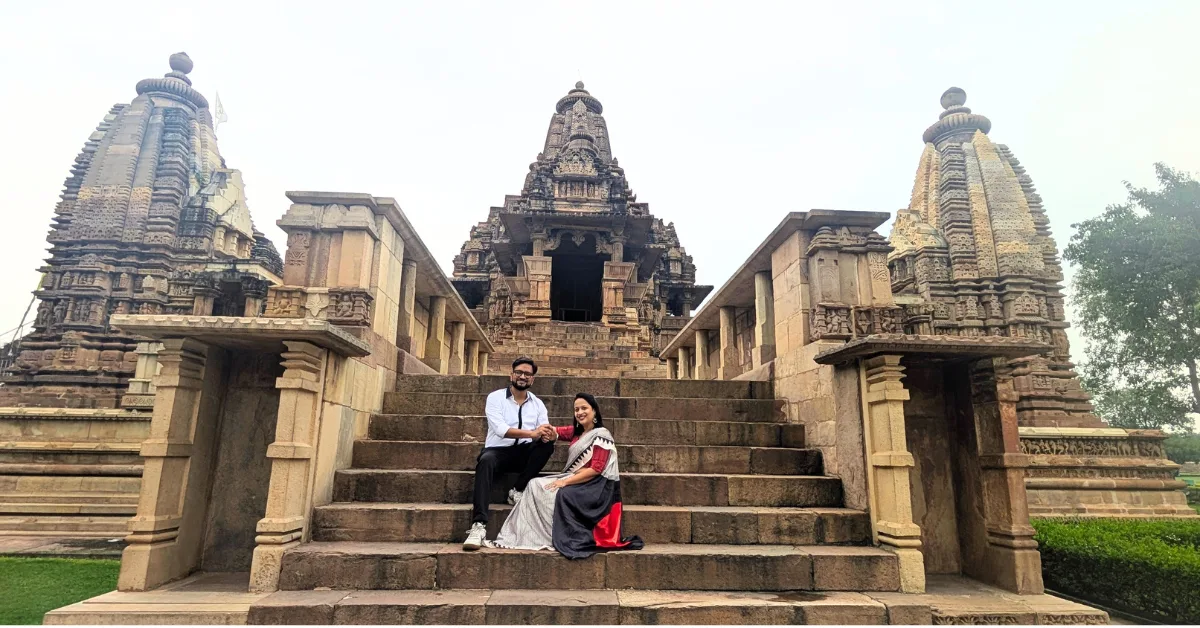
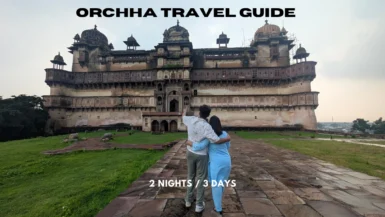
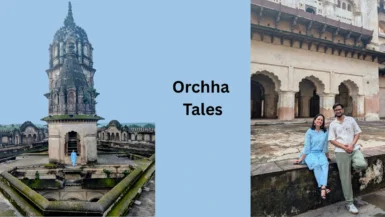
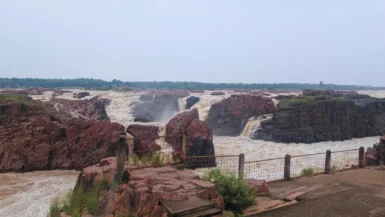
Leave a reply